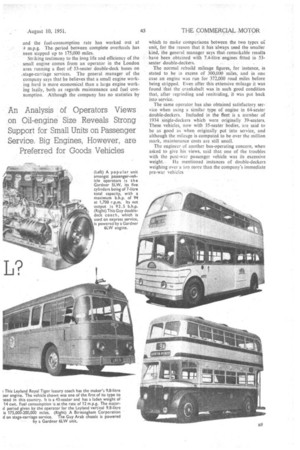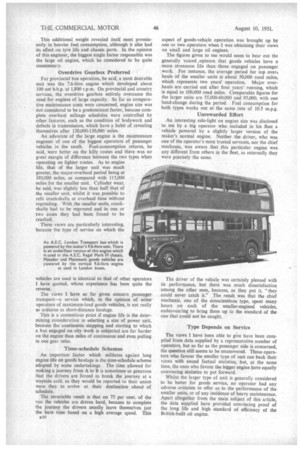BIG ENGINES OR SM) L?
Page 42

Page 43

Page 44

If you've noticed an error in this article please click here to report it so we can fix it.
By P. G. TUCKER
THE two most popular types of oil engine at present used in passenger vehicles and the heavier goods
. vehicles are those •of just over 7 litres capacity and those between 9 litres and 10 litres piston-swept volume. As the smaller engine can and does give excellent Service in both passenger and goods vehicles, what advantage, if any, is to bel obtained from fitting a unit two or more litres larger?
It is usually contended,that whilst: the smaller engine gives a good account of itself, the larger engine Can do the same work with much less 'effort and hence its life between major overhauls is much extended and the overall economy is in its favour. This argument is certainly not borne out by the views of a number of leading operators; in fact, on the passenger side there seems to be a decided preference for the 778-litre units.
Much, of course, depends upon the class of service on which the vehicles are engaged. For instance, take the case of double-deck passenger vehicles operating in a dense industrial area and where the daily runs include a number of stiff gradients. The general manager of an undertaking in the north who bases his views on such conditions, pins his faith to the larger unit.
". Whilst fuel consumption is slightly higher," he says, "this is more than offset by the maintenance of higher schedule speeds and better general performance, including acceleration. The fact, that the larger engine is not ' flogged '. tn the smile extent as a smaller engine would be, results in a saVing in repairs and maintenance."
Opposed to this view is that of another operator in the north Whose vehicles have to 'maintain close -schedules on similar service. The fleet of busesis a
large one and includes both types of engine. n8
This operator is of the opinion that the theory of the big engine being able to take things in its stride whilst the,smaller unit has to do collar-Work is not borne Our in practice. To quote the general manager of the undertaking: "The majority of present-day, drivers will use foot hard down,' no matter what power unit is fitted, • so that no appreciable difference in the wear factor will be apparent." Incidentally, opinions similar to this have been expressed by the majority of operators who have supplied data.
Of the smaller unit, the same operator says: "When we took delivery of the first batch of vehicles, 1 was rather sceptical of the engine being able to maintain the services, but after the teething troubles which were experienced in the early days, it has proved itself to be a remarkable engine, and in every way capable of maintaining a satisfactory service."
The conditions obtaining in the borough concerned are such that the buses are timed to link up with ferry services, so that should a bus be half-a-minute late, the boat will have left and passengers may have to wait 1045 minutes for the next one. This point is mentioned by the operator to show that the small-engined vehicle is capable of satisfactorily maintaining a close schedule.
An average of 200,000 miles has been covered by these vehicles on town work involving frequent stopping,
and the fuel-consumption rate has worked out at ntp.g. The .period. between. complete overhauls has been stepped up to 175,000 miles.
• Striking testimony to the long life and efficiency of the .small engine comes from an -operator in .the London area running a fleet of 53-seater double-deck buses on .stage-carriage services. The general manager of the company says that he believes that a small engine working hard is more economical than a large engine working lazily, both as regards maintenance and fuel consumption. Although the company has no statistics by which to make comparisons between the two types of unit, for the reason that it has always used the smaller ,kind, the general manager says that remarkable results • have been pbtained with 7.4-litre engines fitted in 53seater.. double-deckers. H.
The normal rebuild mileage figures, for instance, is stated to be in excess of 300,000 miles, and in one case an engine was run for 372,000 road miles before being stripped. Even after this extensive mileage it was found 'that the crankshaft was in such good condition that, after regrinding and renitriding, it was put back into service.
The same operator has also obtained satisfactory service when using a similar type of engine in 64-seater double-deckers. Included in thern fleet is a number of 1934 single-deckers which were originally 39-seaters. These vehicles, now with 35-seater bodies, are said to be as good as when originally put into service, and although the mileage is computed to be over the million mark, maintenance costs are still small.
The engineer of another bus-operating concern, when asked to give his views, said that one of the troubles with the post-war passenger vehicle was its excessive weight.He mentioned instances of double-deckers weighing over a ton more than the company's immediate pre-war vehicles This additional weight revealed itself most prominently in heavier fuel consumption, although it also had its effect on tyre life and chassis parts. In the opinion of this engineer, the biggest single factor responsible was the large oil engine, which he considered to be quite unnecessary.
Overdrive Gearbox Preferred
For provincial bus operation, he said, a most desirable unit was the 7.6-litre engine which developed about 100 net b.h.p. at 1,800 r.p.m. On provincial and country services, the overdrive gearbox entirely overcame the need for engines of large capacity. So far as comparative maintenance costs were concerned, engine size was not considered to be a predominant factor, because complete overhaul mileage schedules were controlled by other features, such as the condition of bodywork and defects in transmission, which have a habit of revealing themselves after 120,000-130,000 miles.
An advocate of the large engine is the maintenance engineer of one of the biggest operators of passenger vehicles in the south. Fuel-consumption returns, he said, were better on the hilly routes and there was no great margin of difference between the two types when operating on lighter routes. As to engine life, that of the larger unit was much greater, the major-overhaul period being at 180,000 miles, as compared with 115,000 miles for the smaller unit. Cylinder wear, he said, was slightly less than half that of the smaller unit, whilst it was possible to refit crankshafts at overhaul time without regrinding. With the smaller units, crankshafts had to be reground and in one or two cases they had been found to be cracked.
These views are particularly interesting, because the type of service on which the vehicles are used is identical to that of other operators I have quoted, whose experience has been quite the reverse.
The views I have so far given concern passenger transport—a service which, in the opinion of some operators of maximum-load goods vehicles, is not really so arduous as short-distance haulage.
This is a contentious point if engine life is the determining consideration. in selecting a size of power unit, because the continuous stopping and starting to which a bus engaged on city work is subjected are far harder on the engine than miles of continuous and even pulling in one gear ratio.
Time-schedule Schemes
An important factor which militates against long engine life on goods haulage is the time-schedule scheme adopted by some undertakings. The time allowed for making a journey from A to B is sometimes so generous that the drivers are forced to break the journey at a wayside café, as they would be reported to their union were they to arrive at their destination ahead of schedule.
The invariable result is that on 75 per cent, of the run the vehicles are driven hard, because to complete the journey the drivers usually leave themselves just the bare time based on a high average speed. This aspect of goods-vehicle operation was brought up by one or two operators when I was obtaining their views on small and large oil engines.
The figures given to me would seem to bear out the generally voiced /opinion that goods vehicles have a more strenuous life than those engaged on passenger work. For instance, the average period for top over, hauls of the smaller units is about 50,000 road miles, which represents two years' operation. Major overhauls are carried out after four years' running, which is equal to 100,000 road miles. Comparable figures for the larger units are 55,000-60,000 and 95,000, with one head-change during the period. Fuel consumption for both types works out at the same rate of 10.5 m.p.g.
Unrewarded Effort
An interesting side-light on engine size was disclosed to me by a big operator who included in his fleet a vehicle powered by a slightly larger version of the maker's normal engine. Neither the driver, who was one of the operator's most trusted servants, nor the chief mechanic, was aware that this particular engine was any different from others in the fleet, as externally they were precisely the same.
The driver of the vehicle was certainly pleased with its performance, but there was much dissatisfaction among the other men, because, as they put it, "they could never catch it." The result was that the chief mechanic, one of the conscientious type, spent many hours on each of the smaller-engined vehicles, endeavouring to bring them up to the standard of the one that could not be caught.
Type Depends on Service The views I have been able to give have been compiled from data supplied by a representative number of operators, but so far as the passenger side is concerned, the question still seems to be unanswered. Those operators who favour the smaller type of unit can back their views with sound factual statistics, but, at the same time, the ones who favour the bigger engine have equally convincing statistics to put forward.
Whilst the larger type of unit is generally considered to be better for goods service, no operator had any adverse criticism to offer as to the performance of the smaller units, or of any incidence of heavy maintenance. Apart altogether from the main subject of this article, the data supplied have provided convincing proof of the long life and high standard of efficiency of the British-built oil engine.




















































































